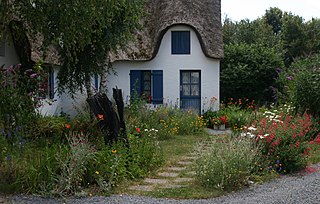
A wildlife garden is an environment created by a gardener that serves as a sustainable haven for surrounding wildlife. Wildlife gardens contain a variety of habitats that cater to native and local plants, birds, amphibians, reptiles, insects, mammals and so on. Establishing a garden that emulates the environment before the residence was built and/or renders the garden similar to intact wild areas nearby (rewilding) will allow natural systems to interact and establish an equilibrium, ultimately minimizing the need for gardener maintenance and intervention. Wildlife gardens can also play an essential role in biological pest control, and also promote biodiversity, native plantings, and generally benefit the wider environment.

The Australian National Botanic Gardens (ANBG) is a heritage-listed botanical garden located in Acton, Canberra, in the Australian Capital Territory, Australia. Established in 1949, the Gardens is administered by the Australian Government's Department of Agriculture, Water and the Environment. The botanic gardens was added to the Commonwealth Heritage List on 22 June 2004.

Royal Botanic Gardens Victoria are botanic gardens across two sites–Melbourne and Cranbourne.

Piper excelsum, commonly known as kawakawa, is a small tree of which the subspecies P. excelsum subsp. excelsum is endemic to New Zealand; the subspecies P. e. subsp. psittacorum is found on Lord Howe Island, Norfolk Island and the Kermadec Islands.
Syndyophyllum is a plant genus of the family Euphorbiaceae, first described as a genus in 1900. It is native to Sumatra, Borneo, and New Guinea.
- Syndyophyllum excelsum K.Schum. & Lauterb. - New Guinea
- Syndyophyllum occidentale Welzen - Sumatra, Borneo

Entandrophragma is a genus of eleven known species of deciduous trees in the family Meliaceae.
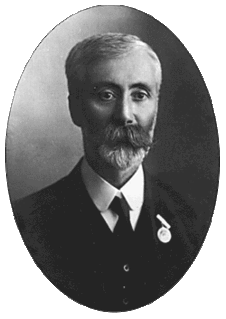
Joseph Henry Maiden was a botanist who made a major contribution to knowledge of the Australian flora, especially the genus Eucalyptus. This botanist is denoted by the author abbreviation Maiden when citing a botanical name.

Dysoxylum is a flowering plant genus of trees and shrubs from the mahogany family, Meliaceae.
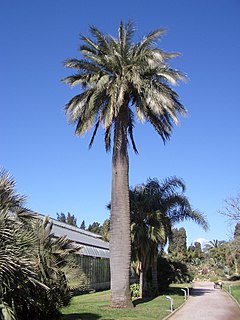
Jubaea is a genus of palms with one species, Jubaea chilensis or Jubaea spectabilis, commonly known in English as the Chilean wine palm or Chile cocopalm, and palma chilena in Spanish. It is native to southwestern South America and is endemic to a small area of central Chile between 32°S and 35°S in southern Coquimbo, Valparaíso, Santiago, O'Higgins, and northern Maule regions.
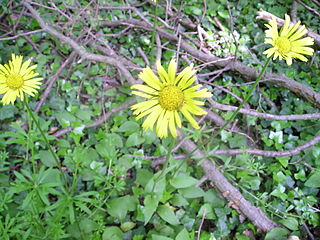
Doronicum is a genus of flowering plants in the sunflower family, known as leopard's bane. They are all herbaceous perennials native to Europe, southwest Asia and Siberia. They produce yellow, daisy-like flowerheads in spring and summer.

Graptophyllum ilicifolium, otherwise known as the Mount Blackwood holly, is a large rainforest shrub which grows in granitic soils. It has shiny, dark green leaves which resemble those of the unrelated holly, and grows best in moist, semi-shaded, well-drained, well-mulched soils. The shrub grows to 5 metres in height and has leaves 7.5 to 10 centimetres long which are shiny, noticeably veined, dark green in colour and have a spinous margin. The flowers are red and in short clusters, each about 2 to 2.5 centimetres in length.

Ligustrum lucidum, the broad-leaf privet, Chinese privetglossy privet, tree privet or wax-leaf privet, is a species of flowering plant in the olive family Oleaceae, native to the southern half of China and naturalized in many places. The name "Chinese privet" is also used for Ligustrum sinense.
Dialium excelsum is a species of flowering plant in the family Fabaceae. It is native to the Democratic Republic of the Congo and Uganda. It is threatened by mining and forest clearing.
Euryodendron is a genus of plant in family Pentaphylacaceae. The genus currently contains a single species, Euryodendron excelsum. It is endemic to China. It is threatened by habitat loss.
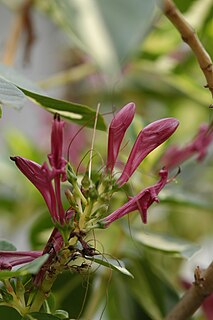
Graptophyllum pictum, the caricature-plant, is a shrub in the family Acanthaceae. It is native to New Guinea, also a well-known garden shrub. There are two varieties: the variegated color one is known as 'white adulsa', and is used combined with coconut water to reduce swelling. The dark-leaved variety is known with trade name 'black adulsa' in India.
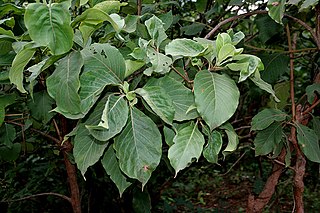
Hymenodictyon is a genus of flowering plants in the family Rubiaceae. It has about 30 species. All are native to the Old World. The wood of Hymenodictyon orixense is soft and has limited use, mostly for boxes. The type species for Hymenodictyon is Hymenodictyon orixense.

The National Herbarium of New South Wales was established in 1853. The Herbarium has a collection of more than 1.4 million plant specimens, making it the second largest collection of pressed, dried plant specimens in Australia, including scientific and historically significant collections and samples of Australian flora gathered by Joseph Banks and Daniel Solander during the voyage of HMS Endeavour in 1770.
David Lloyd Jones is an Australian horticultural botanist and the author of many books and papers, especially on Australian orchids.
Arthrostylidium excelsum is a species of Arthrostylidium bamboo in the grass family.

Hymenodictyon orixense is a species of flowering plant in the family Rubiaceae. It is found in the Indian Subcontinent, south-central China, Mainland Southeast Asia, and the Phillipines.















